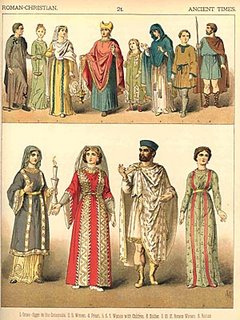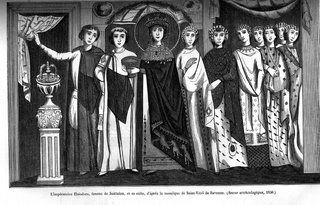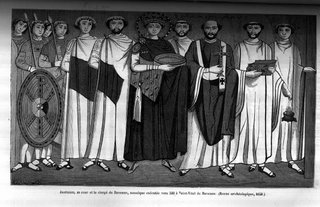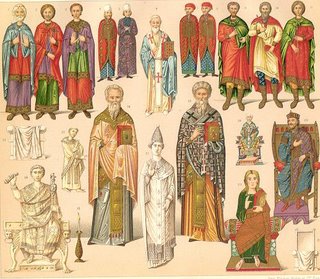
Dress in Byzantium (400-1460ce)
Dress in the Eastern Empire, later to be called Byzantium by the West, (although properly called Romania at the time) was directly taken from the later Roman Empire. Strictly speaking Byzantium/Romania was the late Roman Empire, although it's capitol was Constantinople, and it's religion predominantly Christian. The Eastern Empire continued in the Roman tradition until it was shrunk into the space of little more than Constantinople and the southern tip of Greece by successive wars with the Ottoman Turks and Western Christian countries. In 1460 the last vestige of the Eastern Empire was swallowed up into the Ottoman Empire. For more on this topic see What, If Anything, Is A Byzantine? and THE ROMANS Ancient, Medieval and Modern
 The Emperor Justinian and his court and clergy, c.510
The Emperor Justinian and his court and clergy, c.510
 The Empress Theodora, wife of Justinian, and her suite, c. 510
The Empress Theodora, wife of Justinian, and her suite, c. 510
Long half circle capes were part of male court dress, worn in place of the old toga over the new long sleeved tunica. The most notable feature of the Eastern Empire's dress is it's surface decoration. Unlike the earlier period which left fabric largely undecorated, the people of the Byzantine/Romanian Empire used all manner of woven, embroidered and beaded surface embellishment, particularly on Church vestments and court dress. This style of decoration, and many of the garment shapes, survive to this day in the priestly vestments of Orthodox churches in Greece, Eastern Europe and Russia.
Dress in Early Medieval Europe (400-1200ce)
Contemporary with the first part of the Eastern Empire's rule in the western Mediterranean, Western Europe was going through the period known as the "Dark Ages". One rather pithy scholar pretty well summed up the era (400-900ce) as "five hundred years of camping out". Warfare was pretty constant, commerce pretty nearly dead, and stable social and educational institutions almost non-existent.
Few records survive of dress in this period, although there is some rather spectacular jewelry in the style commonly called Celtic which has mainly been found in archeological sites in the British Isles and the Nordic countries. Like the Eastern Empire the dress of Western Europe seems to have consisted of the long sleeved tunic, half circle capes, & trousers. Western men are more often depicted in the short tunic and trouser combination than in long tunics. Shoes and boots were also worn in place of sandals.
It has been suggested that the reason that clothing became longer, heavier and more fitted in this era is that the world weather pattern shifted at that time to make Europe the much colder continent it is now. (In Roman times the weather was so warm in Northern Europe that they had successful vineyards in England, far north of where it is possible to grow them now).
Another clothing variation popular in Europe was the wearing of a short tunic over a longer fuller one. This was done by persons of both sexes. The over tunic was often heavily embroidered in a manner similar to the Byzantine style.
Women's dress was often similar to the style mentioned above, or simply consisted of a long tunic with a more tight fitting sleeved one beneath. Married women, with the exception of queens, generally veiled their hair, but this was not a hard and fast rule.
In 800ce Charles the Great (aka Charlemagne) was crowned "Holy Roman Emperor" by the Pope in Rome, thus setting up a smaller, rival empire in the West to Romania/Byzantium. In this period (known now as Carolinian) the shape of the old tunic changed by widening at the bottom. Eventually the lower part of the garment (now more often referred to as a gown) was cut like a full skirt.
By the 1000-1200 ce period known as "Early Gothic" (another name intended as a pejorative provided by people at a much later date) the usual cut of the gown (and shorter over tunics) was pretty usually with the wide or circular bottom. Sleeves on the over gowns and/or tunics get wider (especially on women's dress) and there is an overall fashion for conspicuous consumption of fabric.
There had been a pretty popular belief in Western Europe in the years leading up to the first Millennium, that the Christian Second Coming, End of the World, and Judgment Day would happen in the year 1000. This did not really encourage people to build earthly cities for the future or spend time or cash on worldly matters. So material culture, including dress, was pretty limited in it's ostentation before this date. When the world did not end, people in the centuries that followed became more sanguine that The End was not Near, and began displaying more interest in frivolous worldly matters such as dressing better than one's neighbors. This is partly why conspicuous consumption of fine fabric suddenly became popular.

Byzantine court and ecclesiastical dress from


